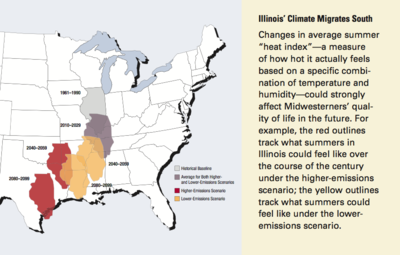I recently attended my home association’s annual meeting, a gentle community affair that focused on reviewing our budget. Only one line item was way up this year – after a record winter in Connecticut, snow removal fees rose 30%. No big surprise.
But I was shocked to learn from the association president that the snow levels and fees would be “back down to normal next year.” Apparently all climate changes would be remedied by December of this year. Phew.
I considered chiming in on the true uncertainty about climate “weirding” and how we could get no snow next winter…or a lot more. But since it’s a relatively small part of our budget, I figured I’d just let the chips fall where they may.
In this case, the level of denial about where we’re really headed as a planet is of little consequence. But what happens when large cities or countries make investment and planning decisions based on either science or denial?
The New York Times just reported on Chicago’s impressive plans for climate adaptation. I spoke last year at an event in Chicago and a climate expert from the Union of Concerned Scientists showed one of the more powerful slides I’ve ever seen on climate impacts (see below). Over time, Illinois will find itself feeling more like the 2010 version of east Texas. As the Times pointed out, models indicate that Chicago will see 70 or more days per year over 90 degrees (vs. 15 each year over the last century).
Source: Union of Concerned Scientists — see report here
The Times article is a fascinating look at how one city is grappling with this possible scenario. The city is shifting to more permeable pavement and planting hardier species of trees (over the last 30 years, they’ve already shifted about one growing zone).
In comparison, witness the sad display of lack of leadership from Texas Governor Rick Perry last month. Facing record droughts, the Governor suggested everyone pray for rain. Faith is fine, but not to the exclusion of actual preparedness.
This divide is starting to play out on the national and global scale. As I’ve written about many times, the U.S. is falling behind on clean economy spending and investment versus China, Germany, Britian, and many others. As Yale 360 (a wonderful publication) reported recently, the U.S. ranks 17th on clean tech spending as a percentage of GDP (Denmark is #1).
The global levels are hard to compare of course, but preparedness in our communities? That’s easy to imagine and the differences are tangible. The unprepared will be struggling with heat, floods, water shortages, and much more. Over time, the gap between states and cities that are ready and areas that are in denial could make the country’s current blue/red divide seem quaint.
(Sign up for Andrew Winston’s blog, via RSS feed, or by email. Follow Andrew on Twitter @GreenAdvantage)



One Response
Diane AtkinsonJuly 26, 2009Of course asitvicts still need be active as this will drive the solutions but I also sense that the whole debate will move dramatically as humanity comes to grips with this problem. This has happened amongst the engaged few but it feels like critical mass is being reached and the debate and responses will accelerate from this point. Individuals have difficulty changing, and societies even more so, but there are some indicators out there of the shift that is underway.Last week I read in the financial review that power companies are struggling to refinance loans for the continued operation of their coal-fired plants. The world of finance is reading the writing on the wall, and this has implications for future investment decisions. This has happened even though Labor is only proposing the weakest of targets with compensation to polluters. So while activism will still be incredibly important, why not smell the roses with the confidence that the battle can be won?